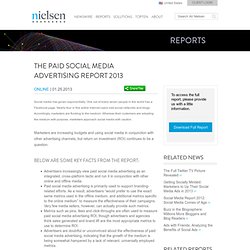

- comScore, Inc. Www.naa.org/~/media/NAACorp/Public Files/AboutNAA/Events/Nielsen-National-Engagement-Study-2013.ashx. Survey Reveals That Digital, Social and Mobile Advertising Appearing as Content Can Be Damaging to Brand Trust. New Research From MediaBrix Finds Majority of Adults Perceive They Have Experienced Misleading Digital Advertising in the Past Year NEW YORK, NY--(Marketwire - Nov 5, 2012) - MediaBrix , the only end-to-end, in-app social and mobile advertising solution for Fortune 500 marketers, commissioned Harris Interactive to survey U.S. online adults in October 2012.

This survey focused on the perceptions about ads that attempt to appear as part of the content in any medium, including in print, on television and on digital, social and mobile platforms. This survey revealed that the majority of online adults who have seen advertising appearing as content 1 in the past 12 months say that the ads negatively impacted or had no impact on their perception of the brand being advertised. When asked about and shown these specific ad types: "This study validates that people respond best to authenticity in advertising no matter the format.
Speaking. Jay Baer speaks and emcees approximately 50 times each year world-wide, for audiences as large as 6,000 (although if you’ve got more people, he’s game!).

Fifty & Five. The Paid Social Media Advertising Report 2013. Social media has grown exponentially.

One out of every seven people in the world has a Facebook page. Nearly four in five active Internet users visit social networks and blogs. Accordingly, marketers are flocking to the medium. Whereas their customers are adopting the medium with purpose, marketers approach social media with caution. Marketers are increasing budgets and using social media in conjunction with other advertising channels, but return on investment (ROI) continues to be a question.
Below are some key facts from the report: Report Gauges Companies' Approach to Advertising on Social Media. Since the arrival of social media platforms, companies have tried to figure out how to best use them to get their messages to consumers, often with mixed results.

Some brands have embraced the notion that social platforms like Twitter allow constant interaction, for better or worse, with their customers. Others have turned away from some strains of social media, as General Motors did last spring when it stopped advertising on Facebook while raising questions about the return on its investment. The move had a ripple effect in the advertising world, with many brands questioning whether the costs of being on social media were worth it. The study found that that 89 percent of advertisers continued to use free social media products.
Nielsen did not release the names of specific social media platforms mentioned by the respondents, but they are likely to include Facebook and Pinterest, as well as Twitter. Social Media Advertising Consortium. Feds issue rules for social media and small screen ads — Twitter and bloggers take note. The Federal Trade Commission issued new guidelines on Tuesday to encourage better disclosures in online ads.

The rules, intended to protect consumers from confusion, come at a time when so-called “content marketing” and “native advertising” are soaring in popularity. The FTC announced the rules in a release stating the agency has updated its 2000 guide, “Dotcom Dislosures,” in order to take account of smaller media screens and the rise of social marketing.
The agency emphasized that traditional disclosure rules, which cover media like radio and television, apply to all forms of the online space as well. These longstanding rules prevent marketers from hiding key terms of an offer and require them to reveal if someone has been paid to endorse a product. The new FTC report contains 22 examples at the end that illustrate how marketers can fall afoul of the rules in the mobile and social media context. 5 Essential Elements Of A Great Twitter Content Strategy. What’s your Twitter strategy?

If you tried answering this question with “Ummm, we tweet a lot, and we use hashtags,” that’s not good enough. To be successful on Twitter – whether you’re tweeting on behalf of a Fortune 500, the small mom-and-pop down the streed or your own personal brand – you need a well-articulated content strategy that covers the who, what, when, why and how. Who is tweeting? Who are you tweeting to? The question of who should be one of the first ones you answer when coming up with your Twitter strategy. You may be a one-person social media shop, and so you’ll be tweeting on behalf of, well, yourself; or you might be part of a 12-person team representing a major brand. If you’re clear about who will be managing the Twitter account off the bat, you won’t run into as many roadblocks when you go to launch a specific campaign, or when two people send conflicting tweets because they didn’t know who was supposed to be manning the account at that time.
Twitter May Be Tops For Marketers, But They Need To Work On Strategy [INFOGRAPHIC] Social Media Advertising Statistics And Trends To Get Your Company Off Its Duff And Online [INFOGRAPHIC]